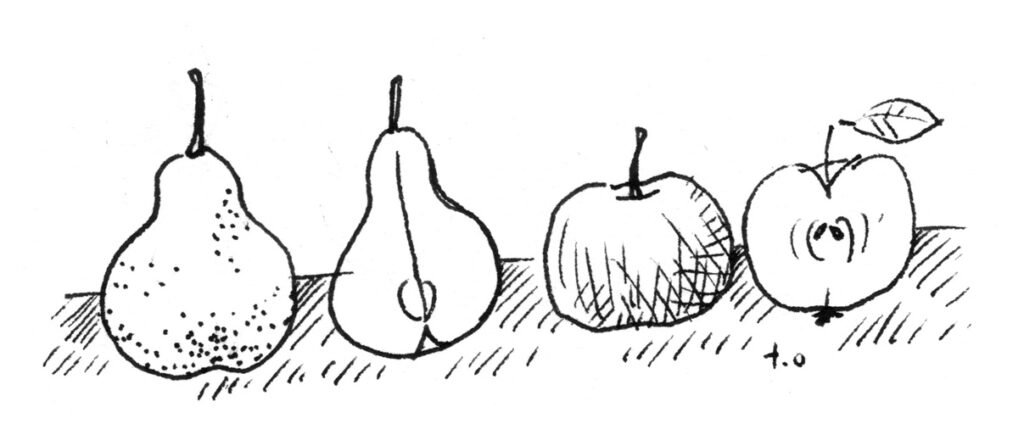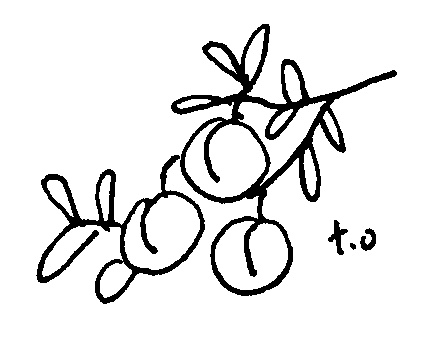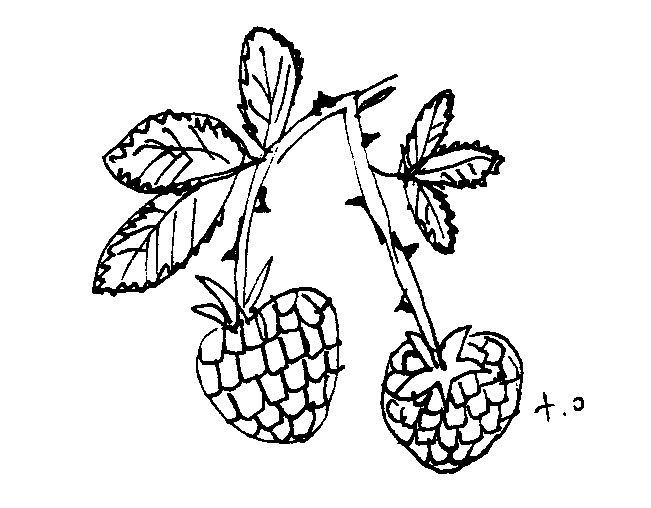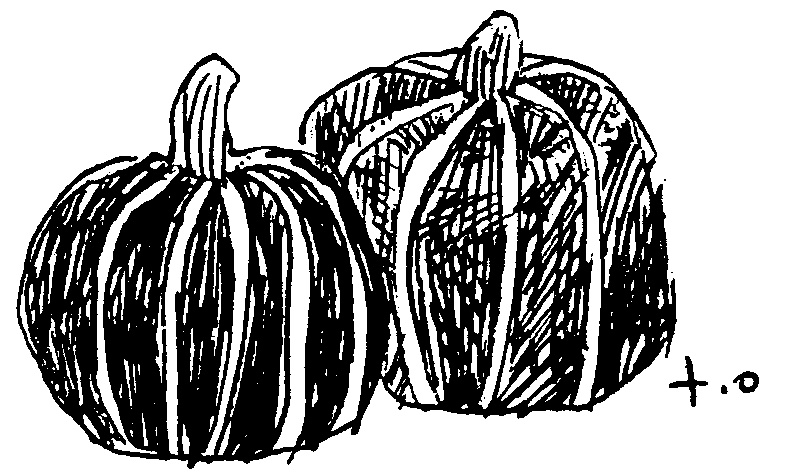Celebrating Fall Flavor and History
By Roberta Bailey
Early last winter, a friend of mine told me about an ancient tree on the farm where she used to live. It was a Northern Spy apple tree. She said it was the old strain of Northern Spy, better than what seems to be around now. Her daughter loved its flavor and had a lot of sentimental attachment to this tree, but the tree was not likely to live much longer. What could be done?
I offered to graft some trees for her. Over the winter, we discussed how to gather scionwood. I ordered some Antonovka apple rootstock. In April she gave me the gathered scionwood, and I grafted the skinny little pieces onto the rootstock and planted them.
While I was grafting these frail bits of scionwood, I felt a bit of panic. They were tiny, with barely any wood beneath the bark. As I cut the wood, it tended to fray. What if none of the grafts took? What if the tree died and I failed to continue this legacy? So, I cut seven more scions from the branches left and grafted them onto a Gray Pearmain apple tree on the edge of my orchard. If they took, they were my insurance: my Northern Spy scionwood storage bank. I could re-graft any of the rootstock that did not take.
The grafts did take. The young trees are thriving in my garden, protected from romping dogs and grandkids with some wire hoops. Most of the grafts in the orchard took as well.

Northern Spy apple trees can take 10 years to mature and fruit. I have a bit of a wait before I get to taste fruit from this particular old strain of Northern Spy apple. Maybe the grafts on the well-established Gray Pearmain tree will expedite the growth and fruiting process. The turnaround time is quite different from trying an heirloom tomato variety or even a plum.
Maine farms are rich in old fruit trees. The flavors are worth seeking out. And just like the heirloom vegetable varieties that we try from year to year, or save seed from for decades, there are a myriad of reasons for planting or buying heritage fruits. Unique, complex flavor profiles are at the top of the list, but do you know that there are pear varieties that store all winter? Dana Hovey and Kaspar’s Winter are two. Pound Sweet apples are mild picked right off the tree but get sweeter when cooked. I use them as part of my berry applesauce. Many old apple varieties keep into late spring. They are rock hard when harvested in October but develop flavor with a few months of storage. That flavor changes every few weeks throughout the winter.
Some varieties were favored for their hardness over their flavor because farmers needed a storage apple that could be packed into a wooden barrel and shipped to cities or across the ocean. The Baldwin apples in my orchard came from scionwood collected from trees on my old farm in Washington County, Maine. There were sales records from the 1920s reflecting barrels of Baldwins delivered by horse-drawn wagon to a train bound for New York City in March of each year. I think Baldwins come into peak flavor in February and March. In a good cellar, they keep until July.
Seek out a fruit-tasting event so you experience the differences. Or buy some heritage fruit varieties sold at a farmers’ market. Like other produce, local fruits have more flavor than commercial fruits in a supermarket. If you find some favorites, consider planting a tree or an orchard. Add rich flavor and history to your yard or farm.
Berry Good Applesauce
5 parts apples, peeled and cored (optional: replace some apples with pears)
1 part berries, fresh or frozen
Cook the apples with an inch of water or cider in a large pot. Stir to keep them from sticking to the bottom of the pot. When softened, add the berries. Cook for a few more minutes. Puree with an immersion blender, or leave chunky if you prefer. (The more types of apples, the more depth of flavor your sauce will have. One can cook the apples with the skins on and eat the sauce that way or put the cooked sauce through a sieve. The skin adds flavor, color and nutrients.)
Applesauce can be frozen or canned. To can: Fill sterilized canning jars, leaving ½-inch headspace at the top. Seal jars and process in a boiling water bath for 10 minutes for pints or quarts.

Apples in Mustard with Mint
Makes 4 cups.
½ cup apple cider
½ cup white or apple cider vinegar
½ tsp. turmeric powder
2 Tbsp. yellow mustard powder
1 Tbsp. yellow mustard seed
1 tsp. sea salt
2 Tbsp. vegetable oil
4 tsp. white flour
12 ounces unpeeled tart apples
⅔ cup fresh spearmint leaves
Core and cut the apples into ¼-inch pieces. Chop the mint very finely and mix with the apples. Set aside.
In a small bowl, whisk together the cider, vinegar, turmeric, mustard powder, mustard seeds and sea salt.
In a small saucepan, combine the flour and oil, and cook over medium heat three to four minutes until thick and light brown. Slowly add in the cider mixture, whisking constantly, until slightly thickened (three minutes). Turn off heat.
Combine the apples and thickened liquids in a bowl. Pack into two pint jars. Refrigerate, allowing flavors to meld for 24 hours before eating. Keeps three weeks.

Seven Tree Farm Plum-Lime Jam
10 cups plums, halved and pitted
Zest from 3 limes
2 Tbsp. lime juice
1 ½ -2 cups honey
5 tsp. low-methoxyl pectin
10 tsp. calcium solution (⅛ tsp. calcium powder mixed into ¼ c. water)
Put ¼ inch of water in a heavy stainless steel pot. Add plums and steam until tender. Puree. Add the lime zest and juice. Mix the pectin into the honey. Stir into the plum mixture. Add the calcium solution.
To can, pour into sterilized half-pint jars, leaving ¼-inch headspace. Seal. Can in a boiling water bath canner for 10 minutes.
To freeze, pour into half-pint canning jars, leaving ½- to 1-inch headspace. Tighten the lids and freeze. Tapered jars can freeze without breakage.
Note: Either hybrid or European plums can be used. The hybrid plums are very zippy and may need extra sweetener. European plums will be mild and need less sweetener.
Pear Gingerbread
Serves 8.
2 cups unbleached white flour
1 cup maple sugar or evaporated cane juice or light brown sugar
2-3 tsp. ground ginger
1 tsp. cinnamon
½ tsp. salt
1 ½ tsp. baking soda
½ c. unsulphured molasses
2 egg whites, lightly beaten
½ cup buttermilk or nut milk
2 Tbsp. fresh lemon juice
2 large pears, peeled, cored and chopped into small pieces
Preheat the oven to 350 F. Lightly grease a 9-inch square baking pan. Combine the dry ingredients in a mixing bowl. Mix the wet ingredients separately. Pour the wet mixture into the dry mixture and just stir, don’t overmix. Add the pears. Pour the batter into the greased pan and bake for 35-40 minutes, until a knife inserted in the center comes out clean. Cut gingerbread into squares and serve warm. (Ice cream or whipped cream are great accompaniments.)
Pear Spinach Salad

Enough of each to feed all:
Tender young spinach, whole or roughly chopped
Carrot, finely grated
Red onion, very thinly sliced
Pears, cored, quartered and thinly sliced
Dressing:
White balsamic vinegar
Olive oil
Salt and pepper
Optional: pureed raspberries or strawberries
Toss together the spinach and grated carrot. Place in individual salad bowls or a large shallow salad bowl. Sprinkle with red onion slices, and arrange the cut pears on top. Dress with vinegar, oil, salt and pepper. If using berries, blend all dressing ingredients together then pour over salad.
Winter Squash Bake

1 large kabocha squash
4-6 apples, peeled
2-4 Tbsp. butter
2-4 Tbsp. maple syrup
Peel and seed the squash. Slice into ¼-inch slices. Slice the apples to a similar thickness. Layer the squash and apples into a buttered baking pan or casserole dish. Melt the butter and syrup together. Drizzle over the layered squash and apples. Bake at 350 F until tender. Serve warm.
About the author: Roberta grows an abundance of produce and saves seeds at her Seven Tree Farm in Vassalboro, Maine. She is the longest-running columnist for The MOF&G.
This article was originally published in the fall 2022 issue of The Maine Organic Farmer & Gardener.
Looking for more seasonal recipes? Sign up for MOFGA’s Local and Organic Kitchen Newsletter here.
